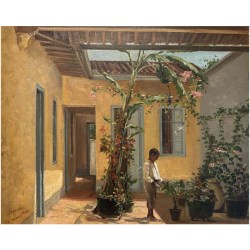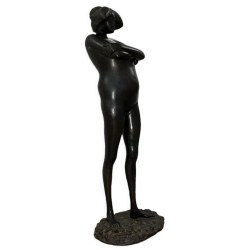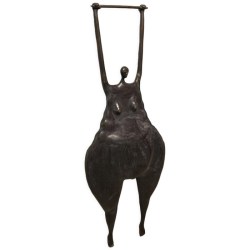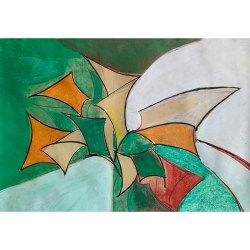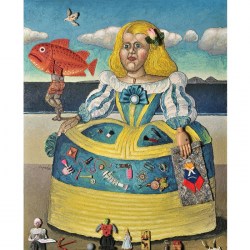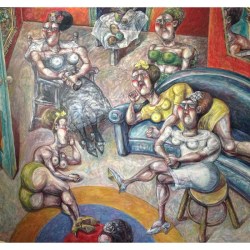Review
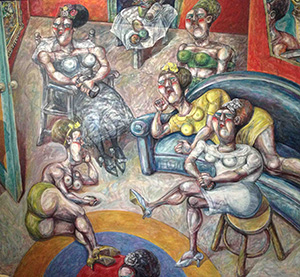
Specially emphasizing the human condition, CEPEDA creates a new pictorial proposal within the "New Venezuelan Figurative". Since the fifties, this tendency inscribed a fundamental rupture with the worn out landscaping. Born in Zulia of such a unique geography, the painter stamps in the canvas personal mythologies and collective memories, where fiction and reality interplay.
Different production levels can be seen in the show: a first level, the VENUSES, where the erotic feminine figuration predominates; feminine stamps and portraits and women in the nude. The series "THE PAINTER AND HIS MODEL", emphasizes not only the sensuous splendor of the Venus but also the self-portrait of the artist included in the canvas. As an example the piece, "…In the mountain of Sorte". The series "EROTICS", in small format, he explores the concept of the body and its desires. Outstand "Self-portrait with Model" numbers 1, 2 and 5 with a strong erotic expressiveness.
A second level, the series "From the Family Album", themes of the individual recollection. The outstanding piece "Portrait of Two Children with curtain as a Backdrop" a great ironic-dramatic theatricality; Two children smile over a donkey toy; as background, a landscape painting with strong warms framing them and a side view of an ambiguous personage to the left. A magical-realistical tale that emphasizes the associative correspondence of the elements.
A third level, the series "Marians of Austria" mother of the Infant Margarita, conceptualized by Cepeda.
A fourth level, the "Self-portraits of the Painter". Among those, the "Self-portrait with an Angel": outside stands the painter palette and brush in his hand and very majestic, looking at us attentively; in the heights, a feminine angel "flies"; in the back, a parrot, a house and a half shown easel, conform a discontinued metarealistic rhetoric.
A fifth level, "Assemblings", through a different technical mean, he achieves a new sign-object semeiology.
FEMININE FIGURATIONS: ABOUT VENUS AND EROTICS
CEPEDA transforms the feminine anatomy into erotic entities. Womanly figures, gelatinous and mellow brushes with corpulent volumes of unpredictable contortions. Sensuous bodies with contundent corporeity and grayish burnished palettes.
The axis is the feminine figure: a whole woman attesting to her autonomous strength. Surpassing the Renaissance, the Baroque and the Venetian School, or the beginnings of Picasso or Matisse, the painter constructs, in the best-achieved eclecticism, the figure of a woman that is at the same time real and sketched, but also cloudy and mellow; descriptive and emblematic but at the same time imaginative and chimerical. It is an invention of counterparts in perfect cohabitation. And in a symbolic sense, it is an Archetypal Venus, odalisque of modernity.
These genres we find as linked to the Venus:
A - Feminine stamps and portraits: heroines of a domestic world that prices and guards them. Examples: "Resting Woman with Window" and "Woman Sitting".
B - Feminine Nudes: in the purest sensuality: such as "Nude with Plane": musculous and geometric, the frontal woman sitting on the couch, illogically holding a plane. Outstand her outrageous feminine parts, highly erotic and with great physical presence. The piece "Nude with T.V. #1 and #2" are inspired in Goya. The woman in each piece rests diagonally on a sofa, escorted by objects that do not seem to correspond: a bird flying, a TV set. The metarealistic ambit of the mitography of the artist is secured.
C - The series "The painter and his Model": posts the eternal problem of the painter and his muse; the creator, the physical reality and its transmutation to the canvas. The piece "The spectator # 1": a thoughtful seductive Venus posing for the painter with thick spectacles, only attentive to his work. His canvas, as in Velasquez' "Las Meninas", is counter faced and we cannot see what he is painting. Behind him, a lady facing us stares at the painting. It is a circle of secrets, a domestic scene of labyrinthic passages. To the right, a fragment of a woman's foot, in high heels, "departing" from the visible space of the painting. Who is it? We do not know.
CEPEDA in each scene includes objects and characters that do not correspond to the story, thus creating an undeveloped mystery; an "umheimliche" or "unsettling weirdness" as Freud would say. A scenery with unsettling locations, enclosed spaces, where inexplicable subjects or landscapes appear.
D - The series "Erotics": it is there raised the exacerbation and climatic transcendence of the feminine body, her ecstatic strength, her primary power, her paradisiacal limits; the visuals of love and desire. Outstands the work: … "In the Open" No. 5, in the architectonic composition of warm colors, the painter appears to wrap his muse with a canvas, interacting lovingly with her. Warm chromes promote a great expressive visual.
THE VELAZQUIAN ROYALTY: ABOUT MARIAN OF AUSTRIA
The royalty, the sovereigns, were obligatory iconographies
in times when power laid with the Courts. Courtesan painters such as Velasquez and Goya, in Spanish painting, arrived in South America as schemes and plastic-formal transferences, but also as a symbolic inheritance of the hierarchical power and authority.
CEPEDA recaptures the stoic authority of Mariana of Austria, just like other artists have fixed the scheme of the Infanta. This is a series made through the reconceptualization of an original, creating CEPEDA a hieratical, hypnotic icon with a demolishing look and an authoritarian attitude, which puts down any subordinate look. The painter succeeds in transcribing the rank of the character with his personal means, without loosing the morphological substance that characterizes him. CEPEDA's Marians are primitive matters of a high metatextuality, interplaying between reality and the metaworld.
ASSSEMBLIES.-
Objects of the house, the street, industrial objects interlaced to create figures: "Freudian Character": the portrait of a woman with waste objects perfectly geared. Outstands a shoe of the artist with two fruits inside, painted in"kitsch" pink, in allegation to the bust. Strings, boards, can openers form the profile and internal corporeity. Androgynous being with a head in cut wood and hypnotic eyes, states his indubitable presence. "Devils Head", with a wooden basin painted in white as a background and butterfly stickers, begin the outlining of an anthropologic totem.
The base of an iron is the face, with an African-like cut; screws, wires and bullet shells make the details of the face that resembles an archaic mask.
This is a heterogeneous exhibition in its themes, but maintaining the erotism of the feminine iconography in all of the pieces and also the mystery and the incongruity of the magic and realistic elements typical of the Latin American nature. The conducting threads: the look of the painter at the femininity and his capacity to create the mystery and oddness in the theatricality of the scenes.


